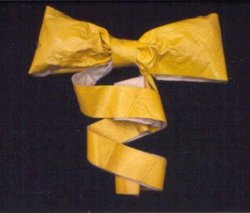Yellow ribbon
|
|
A yellow ribbon is a symbol with various meanings, mostly associated with those waiting for the return of a loved one or of military troops who are temporarily unable to come home. It is also sometimes used with political implications, and at county and state fairs in the United States, it indicates a fourth-place finish in a contest.
| Contents [hide] |
"She Wore a Yellow Ribbon"
In the United States military, the symbol of the yellow ribbon is used in this popular marching song, with lyrics altered from the song She Wore a Yellow Ribbon written by Russ Morgan and performed by several popular musicians of the 1940s including Mitch Miller and The Andrews Sisters. The text of the Army version approximates the following, with local variations:
Around her neck she wore a yellow ribbon
She wore it in the springtime
And in the month of May
And if you ask me why the heck she wore it
She wore it for her soldier who was far far awayFar away, far away
She wore it for her soldier
Who was far, far awayAround the block she pushed a baby carriage
She pushed it in the springtime
And in the month of May
And if you ask me why the heck she pushed it
She pushed it for her soldier who was far far awayFar away, far away
She pushed it for her soldier
Who was far, far away
The words and meter were probably changed for cadence, as the lines are typically sung in time to the steps of the march by the drill instructor and responded to by the troops. The expletive fuck is often substituted for heck and a specific kind of soldier for soldier, i.e., trainee, MP, etc.
"Tie a Yellow Ribbon Round the Ole Oak Tree"
The symbol became widely known in civilian life in the 1970s. It was the central theme of the popular song "Tie a Yellow Round the Ole Oak Tree", performed by Tony Orlando and Dawn, as the sign a released convict requested from his wife or lover, to indicate that she still wanted him and that he would therefore be welcome to return home. He would be able to see it from the bus driving by their house, and would stay on the bus in the absence of the ribbon. He turned out to be very welcome: there were a hundred yellow ribbons.
From the Library of Congress:
- In October of 1971, newspaper columnist Pete Hamill wrote a piece for the New York Post called "Going Home." In it, college students on a bus trip to the beaches of Fort Lauderdale make friends with an ex-convict who is watching for a yellow handkerchief on a roadside oak. Hamill claimed to have heard this story in oral tradition.
- In June of 1972, nine months later, The Readers Digest reprinted "Going Home." Also in June 1972, ABC-TV aired a dramatized version of it in which James Earl Jones played the role of the returning ex-con. One month-and-a-half after that, Irwin Levine and L. Russell Brown registered for copyright a song they called "Tie a Yellow Ribbon Round the Ole Oak Tree." The authors said they heard the story while serving in the military. Pete Hamill was not convinced and filed suit for infringement.
- One factor that may have influenced Hamill's decision to do so was that, in May 1973, "Tie A Yellow Ribbon" sold 3 million records in three weeks. When the dust settled, BMI calculated that radio stations had played it 3 million times--that's seventeen continuous years of airplay. Hammill dropped his suit after folklorists working for Levine and Brown turned up archival versions of the story that had been collected before "Going Home" had been written. [1] (http://www.loc.gov/folklife/ribbons/ribbons.html)
Middle East conflicts
During the Iranian hostage crisis of the late 1970s, the yellow ribbon was used a symbol of support for the hostages held at the U.S. embassy in Teheran. It primarily symbolized the resolve of the American people to win their safe release, and featured prominently in the celebrations of their return home in early 1981.
The yellow ribbon saw renewed popularity in the United States during the Gulf War in the early 1990s. It appeared along with the slogan "support our troops", in the form of yellow ribbons tied to trees, and countless other contexts. It often had the implied meaning of supporting the Desert Shield and Desert Storm troop deployments themselves and/or loyalty to President George Bush, and therefore became somewhat politicized. It appeared again during the 2003 Invasion of Iraq with similar meanings, most prominently in the form of a yellow ribbon printed on magnetized material and displayed on the outside of automobiles.

